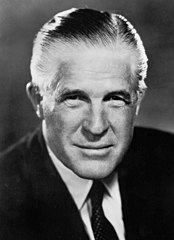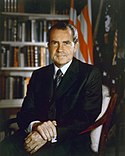George W. Romney
| ||
 | ||
| Pełne imię i nazwisko | George Wilcken Romney | |
| Data i miejsce urodzenia | 8 lipca 1907 Chihuahua | |
| Data i miejsce śmierci | 26 lipca 1995 Bloomfield Hills | |
| Sekretarz urbanizacji USA | ||
| Okres | od stycznia 1969 do stycznia 1972 | |
| Przynależność polityczna | Partia Republikańska | |
| Poprzednik | Robert Coldwell Wood | |
| Następca | James Thomas Lynn | |
George Wilcken Romney (ur. 8 lipca 1907 w Chihuahua, zm. 26 lipca 1995 w Bloomfield Hills) – amerykański polityk.
Życiorys
Urodził się 8 lipca 1907 roku na terenie meksykańskiego stanu Chihuahua[1]. Studiował na University of Utah i George Washington University, jednakże nie ukończył żadnej z tych uczelni[1]. Rozpoczął działalność biznesową, pracując w Aluminum Company of America, a następnie w American Motors Corporation, którego został prezesem[1]. W 1962 roku zaangażował się w działalność polityczną, zostając działaczem Partii Republikańskiej i kandydując z jej ramienia na stanowisko gubernatora Michigan[1]. Wygrał wybory, a następnie uzyskał dwie kolejne reelekcje, pełniąc urząd do czasu rezygnacji w 1969 roku[1]. W prawyborach, poprzedzających wybory w 1968 roku, bezskutecznie ubiegał się o nominację prezydencką[1]. W 1969 roku prezydent Richard Nixon powołał go na stanowisko sekretarza urbanizacji[2]. Funkcję tę pełnił do 1972 roku, kiedy to zastąpił go James Thomas Lynn[2]. Romney zmarł 26 lipca 1995 roku w Bloomfield Hills i został pochowany w Brighton[1].
Był żonaty z Leonore LaFount, z którą miał czworo dzieci (w tym Mitta)[1].
Przypisy
| ||||
| ||||||||||||||
Media użyte na tej stronie
Logo of the United States White House, especially in conjunction with offices like the Chief of Staff and Press Secretary.
Seal of the United States Department of Housing and Urban Development.
The seal was originally unveiled on November 10, 1966, and later defined in law (Federal Register 32FR366-67 and 24 CFR subtitle A, §11.1, both since removed as part of a streamlining of the federal code). The seal was defined as:
On a white background within a circle composed of the words, "U.S. Department of Housing and Urban Development," is an eagle and two stars. The six upper bars depicting the upper portion of the eagle's wings, the torso of the eagle, the star at the right of the eagle, and the words, "U.S. Department of Housing and Urban Development," are colored blue. The eight lower bars depicting the lower portion of the eagle's wings and the star at the left of the eagle are colored green."
The seal is a representative of high rise buildings simulating an eagle and giving emphasis to the "urban" in HUD's name. The eagle (shown abstractly) is a symbol of Federal authority. The use of green symbolizes open space, land, growth and prosperity. The blue in the Seal alludes to the quality of life and environment in America's cities.
More information here.Official portrait of then-Secretary of Housing and Urban Development George W. Romney.






